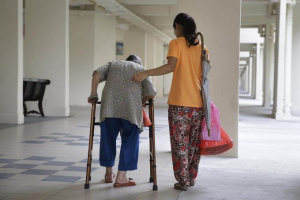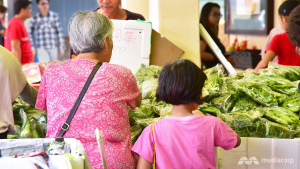Income Tax in Singapore: Income Tax Reliefs (2020): Difference between revisions
Dayana Rizal (talk | contribs) |
Dayana Rizal (talk | contribs) No edit summary |
||
| Line 70: | Line 70: | ||
<nowiki>*</nowiki>He claimed the course fees within two years of taking the course. | <nowiki>*</nowiki>He claimed the course fees within two years of taking the course. | ||
==Foreign Maid Levy (FML) Relief - From S$600*== | == CPF Cash Top-up Relief - Up to S$14,000 == | ||
You are eligible for this relief if you: | |||
(i) Hold a Singapore NRIC | |||
(ii) Have made cash top-ups into your '''<u>Special Account</u>''' or '''<u>Retirement Account</u>''' | |||
(iii) Have made case top-ups into your family member's Special Account or Retirement Account | |||
The amount claimable is capped at $7,000 for self top-up '''<u>AND</u>''' $7,000 for family top-up. More information can be found on the [https://www.iras.gov.sg/IRASHome/Individuals/Locals/Working-Out-Your-Taxes/Deductions-for-Individuals/CPF-Cash-Top-up-Relief/ IRAS website]. | |||
== CPF Relief for Employees == | |||
This relief is for employed individuals who have made the '''<u>compulsory monthly contributions</u>''' to their CPF accounts.<ref>“[https://www.iras.gov.sg/IRASHome/Individuals/Locals/Working-Out-Your-Taxes/Deductions-for-Individuals/CPF--Central-Provident-Fund--Relief-for-Employees/ CPF (Central Provident Fund) Relief for Employees]”. ''IRAS.'' Accessed on 12 March 2020.</ref> How much CPF relief you get is based on your (i) '''<u>Ordinary Wage</u>''' (OW) and (ii) '''<u>Additional Wage</u>''' (AW). The following sections illustrate the steps in calculating CPF reliefs. | |||
=== Step 1. Calculate Your Ordinary & Additional Wages === | |||
Your Ordinary Wage is how much you made '''<u>in a year</u>''' before CPF deduction. Additional Wage consists of extra payments that are not your monthly salary - for example, year-end bonuses. | |||
==== For Example ==== | |||
Catelyn is 29 years old. In 2019, she earned '''<u>$7,000</u>''' a month (before CPF) in 2019. That year, she received a year-end '''<u>bonus of $14,000</u>'''. Her OW and AW for 2019 are as such. | |||
{| class="wikitable" | |||
! | |||
!Ordinary Wage | |||
!Additional Wage | |||
|- | |||
|'''Amount''' | |||
|$84,000 | |||
|$14,000 | |||
|- | |||
|'''Formula''' | |||
| | |||
$7,000 x 12 months (No. of Months Worked) | |||
| - | |||
|} | |||
=== Step 2. Find Out Your Annual Wage Ceilings === | |||
This will affect whether your relief will be '''<u>limited</u>''' to the wage ceiling. If your OW or AW '''<u>exceed</u>''' their respective wage ceilings, you are limited to a CPF relief amounting to '''<u>20% of the annual wage ceiling</u>'''. | |||
(i) Ordinary Wage Ceiling: $6,000 a month | |||
(ii) Additional Wage Ceiling: Differs based on your salary | |||
==== For Example ==== | |||
Considering that Catelyn worked for the whole of 2019, her OWC and AWC are as such. | |||
{| class="wikitable" | |||
! | |||
!Catelyn's Ordinary Wage | |||
!Ordinary Wage Ceiling | |||
!Catelyn's Additional Wage | |||
!Additional Wage Ceiling | |||
|- | |||
|'''Amount''' | |||
|$84,000 | |||
|$72,000 | |||
|$14,000 | |||
|$18,000 | |||
|- | |||
|'''Formula''' | |||
| - | |||
| | |||
$6,000 x 12 months (No. of Months Worked) | |||
| - | |||
| | |||
$102,000* - $84,000 (Catelyn's Ordinary Wage) | |||
<nowiki>*</nowiki>This number is the same for everyone | |||
|- | |||
|'''Conclusion''' | |||
| colspan="2" |OWC exceeded | |||
| colspan="2" |AWC not exceeded | |||
|} | |||
With an OW of $84,000, Catelyn '''<u>exceeded</u>''' the $72,000 '''<u>OWC</u>'''. However, she did not surpass the AWC. | |||
=== Step 3. Calculate Your Total Relief Amount === | |||
Your total CPF relief amount is the '''<u>sum</u>''' of what you can claim for your OW and AW. | |||
==== For Example ==== | |||
{| class="wikitable" | |||
! | |||
! colspan="2" |Ordinary Wage | |||
!Additional Wage | |||
|- | |||
|'''Terms''' | |||
| colspan="2" |Catelyn's Ordinary Wage '''<u>exceeds</u>''' the Ordinary Wage Ceiling | |||
|Catelyn's Additional Wage '''<u>did not</u>''' exceed the Additional Wage Ceiling. | |||
|- | |||
|'''Amount Claimable''' | |||
| colspan="2" |$14,400 | |||
|$2,800 | |||
|- | |||
|'''Formula''' | |||
| colspan="2" | | |||
20% x $72,000 (Ordinary Wage Ceiling) | |||
| | |||
20% x $14,000 (Catelyn's Additional Wage) | |||
|- | |||
|'''Gross Amount Claimable''' | |||
| colspan="3" |Under the above conditions, Catelyn is allowed to claim a CPF Relief valued at '''<u>$17,200</u>'''. | |||
|- | |||
|'''Formula''' | |||
| colspan="3" | | |||
$14,400 (Amount Claimable for OW) + $2,800 (Amount Claimable for AW) | |||
|} | |||
== Foreign Maid Levy (FML) Relief - From S$600* == | |||
<blockquote>*As of April 2020, the foreign maid levy had been increased from $265 to $300 a month.<ref>Chuang Peck Ming. "[https://www.businesstimes.com.sg/government-economy/singapore-budget-2018/singapore-budget-2018-maid-levy-to-go-up-from-april-2019 Singapore Budget 2018: Maid levy to go up from April 2019]". ''Business Times''. February 20, 2018. Accessed on 19 March 2020.</ref> As such, the relief amount has increased correspondingly.</blockquote>This relief is for '''<u>female</u>''' tax residents only. Under this relief, married, divorced or widowed mothers with school-going children can claim the '''<u>foreign domestic worker levy</u>''' paid in the previous year - subject to the following '''<u>Terms & Conditions</u>'''.<ref>“[https://www.iras.gov.sg/IRASHome/Individuals/Locals/Working-Out-Your-Taxes/Deductions-for-Individuals/Foreign-Maid-Levy--FML--Relief/ Foreign Maid Levy (FML) Relief]”. ''IRAS.'' Accessed on 13 March 2020.</ref> | <blockquote>*As of April 2020, the foreign maid levy had been increased from $265 to $300 a month.<ref>Chuang Peck Ming. "[https://www.businesstimes.com.sg/government-economy/singapore-budget-2018/singapore-budget-2018-maid-levy-to-go-up-from-april-2019 Singapore Budget 2018: Maid levy to go up from April 2019]". ''Business Times''. February 20, 2018. Accessed on 19 March 2020.</ref> As such, the relief amount has increased correspondingly.</blockquote>This relief is for '''<u>female</u>''' tax residents only. Under this relief, married, divorced or widowed mothers with school-going children can claim the '''<u>foreign domestic worker levy</u>''' paid in the previous year - subject to the following '''<u>Terms & Conditions</u>'''.<ref>“[https://www.iras.gov.sg/IRASHome/Individuals/Locals/Working-Out-Your-Taxes/Deductions-for-Individuals/Foreign-Maid-Levy--FML--Relief/ Foreign Maid Levy (FML) Relief]”. ''IRAS.'' Accessed on 13 March 2020.</ref> | ||
Revision as of 16:08, 20 March 2020
This entry is one of two Income Tax Guides for Singaporeans on Wiki.sg. Part One explains how you should calculate your income tax. Part Two complies all the Income Tax Reliefs that can potentially reduce how much tax you pay.

Government-initiated tax relief schemes lower the amount of tax payable by reducing the individual's chargeable income.[1] Individuals can claim up to $80,000 of tax reliefs per financial year.[2] This entry summarises all there is to know about the current income tax relief schemes in Singapore (as of 2020).
Overview
Tax reliefs are given by the government as recognition for good social behaviour like family formation, filial piety, National Service and upgrading of skills.[3]
General Eligibility
Tax reliefs are generally applicable to Singapore Citizens, Permanent Residents and some foreign tax residents. In Singapore, you are considered a tax resident if you fulfil the following criteria:
(i) Singapore Citizen or Permanent resident
(ii) Foreigners who have stayed and worked in Singapore for more than 183 days (approximately six months)
Course Fee Relief - Up to S$5,500
Tax residents who have upgraded their skills outside of work can qualify for the Course Fees Relief.[4] The following section highlights the Terms & Conditions of this relief.
Course Fees Claimable

The Course Fee Relief covers the following fees: (i) Aptitude Test Fees (ii) Examination Fees (iii) Registration Fees (iv) Tuition Fees.
| Can Claim | Cannot Claim | |
|---|---|---|
| Type of Courses | Courses that have not been subsidised or reimbursed* | Fully or partially subsidised courses |
| Courses relevant to your vocation, profession or employment** | Courses that fall under these categories:
(i) Social Media Skills (ii) Photography (iii) Internet Surfing | |
| Amount Claimable | Up to $5,500 | > $5,500 |
| No. of Courses | Unlimited | - |
*By the employer or any other organisation.
**Polytechnic and university courses are not eligible for claim if the individual has never been employed in the relevant field.
Example
Hafiz was an engineer. In 2017, he quit his job and took up a baking course which he completed in October that year. He could not claim course relief back then as the course was unrelated to his previous profession. In January 2019, Hafiz opened a bakery and earned S$32,000 that year. With his timely* career switch, he can now claim course relief. Below shows the claim relief he is entitled to.
| Year | Year of Assessment (YA) | Annual Income | Course Fee | Course Fee Relief |
|---|---|---|---|---|
| 2017 | 2018 | $75, 000 | S$3,000 | Not Applicable |
| 2018 | 2019 | - | - | - |
| 2019 | 2020 | $32,000 | $3,000 |
*He claimed the course fees within two years of taking the course.
CPF Cash Top-up Relief - Up to S$14,000
You are eligible for this relief if you:
(i) Hold a Singapore NRIC
(ii) Have made cash top-ups into your Special Account or Retirement Account
(iii) Have made case top-ups into your family member's Special Account or Retirement Account
The amount claimable is capped at $7,000 for self top-up AND $7,000 for family top-up. More information can be found on the IRAS website.
CPF Relief for Employees
This relief is for employed individuals who have made the compulsory monthly contributions to their CPF accounts.[5] How much CPF relief you get is based on your (i) Ordinary Wage (OW) and (ii) Additional Wage (AW). The following sections illustrate the steps in calculating CPF reliefs.
Step 1. Calculate Your Ordinary & Additional Wages
Your Ordinary Wage is how much you made in a year before CPF deduction. Additional Wage consists of extra payments that are not your monthly salary - for example, year-end bonuses.
For Example
Catelyn is 29 years old. In 2019, she earned $7,000 a month (before CPF) in 2019. That year, she received a year-end bonus of $14,000. Her OW and AW for 2019 are as such.
| Ordinary Wage | Additional Wage | |
|---|---|---|
| Amount | $84,000 | $14,000 |
| Formula |
$7,000 x 12 months (No. of Months Worked) |
- |
Step 2. Find Out Your Annual Wage Ceilings
This will affect whether your relief will be limited to the wage ceiling. If your OW or AW exceed their respective wage ceilings, you are limited to a CPF relief amounting to 20% of the annual wage ceiling.
(i) Ordinary Wage Ceiling: $6,000 a month
(ii) Additional Wage Ceiling: Differs based on your salary
For Example
Considering that Catelyn worked for the whole of 2019, her OWC and AWC are as such.
| Catelyn's Ordinary Wage | Ordinary Wage Ceiling | Catelyn's Additional Wage | Additional Wage Ceiling | |
|---|---|---|---|---|
| Amount | $84,000 | $72,000 | $14,000 | $18,000 |
| Formula | - |
$6,000 x 12 months (No. of Months Worked) |
- |
$102,000* - $84,000 (Catelyn's Ordinary Wage) *This number is the same for everyone |
| Conclusion | OWC exceeded | AWC not exceeded | ||
With an OW of $84,000, Catelyn exceeded the $72,000 OWC. However, she did not surpass the AWC.
Step 3. Calculate Your Total Relief Amount
Your total CPF relief amount is the sum of what you can claim for your OW and AW.
For Example
| Ordinary Wage | Additional Wage | ||
|---|---|---|---|
| Terms | Catelyn's Ordinary Wage exceeds the Ordinary Wage Ceiling | Catelyn's Additional Wage did not exceed the Additional Wage Ceiling. | |
| Amount Claimable | $14,400 | $2,800 | |
| Formula |
20% x $72,000 (Ordinary Wage Ceiling) |
20% x $14,000 (Catelyn's Additional Wage) | |
| Gross Amount Claimable | Under the above conditions, Catelyn is allowed to claim a CPF Relief valued at $17,200. | ||
| Formula |
$14,400 (Amount Claimable for OW) + $2,800 (Amount Claimable for AW) | ||
Foreign Maid Levy (FML) Relief - From S$600*
*As of April 2020, the foreign maid levy had been increased from $265 to $300 a month.[6] As such, the relief amount has increased correspondingly.
This relief is for female tax residents only. Under this relief, married, divorced or widowed mothers with school-going children can claim the foreign domestic worker levy paid in the previous year - subject to the following Terms & Conditions.[7]
Terms & Conditions

| Terms & Conditions | |||
|---|---|---|---|
| Applicant Status | Employed female with children | ||
| Marital Status | Married and lives with husband | ||
| Married but husband is not a tax resident | |||
| Legally separated but children live with you | |||
| Child Status | Eligible for the Qualifying Child Relief (QCR) | Below 16 years old | |
| Full-time student at any educational institute | |||
| No annual income of more than $4,000 | |||
| Amount Claimable* | $300 per month | First Foreign Maid | The total foreign domestic worker levy paid in the previous year can be claimed twice |
| $450 per month | Second Foreign Maid | ||
*Per domestic worker.
Example 1
A family hired a domestic worker for only three months after April 2019. As such, the family paid a Foreign Maid Levy amounting to:
$900 = $300 (monthly levy amount) x 3 (no. of months paid)
Under this relief, the family can claim double the above amount ($900) to receive a $1,800 claim.
Example 2
A family hired a total of three separate domestic workers in 2019. The working female can only claim the relief for one of the maids - whichever has the higher value (the Second Foreign Maid). The table below shows the relief amount entitled to the family in YA2020.
| First Foreign Maid | Second Foreign Maid | Third Foreign Maid | ||||
|---|---|---|---|---|---|---|
| Levy Rate (per month) | $265 | Jan to Mar 2019 | $265 | Jan to Mar 2019 | - | |
| $300 | Apr to Dec 2019 | $450 | Apr to Dec 2019 | $450 | Apr to Dec 2019 | |
| No. of Months | 12 months | 12 months | 9 months | |||
| Total Levy Paid |
$3,495 = ($265 x 3 months) + ($300 x 9 months) |
$4,845 = ($265 x 3 months) + ($450 x 9 months) |
$4,050 = $450 x 9 months | |||
Under this relief, the family can claim double the above amount ($4,845) to receive a $9,690 claim.
For Married Couples
The following reliefs are for married tax residents who are financially supporting their spouse. Legally separated individuals may be eligible for the relief if they fulfil the following Terms & Conditions.
Spouse Relief (SSR) - Up to $2,000
| Terms & Conditions | Spouse | Legally Separated Spouse |
|---|---|---|
| Spouse Status | Must be living in the same household in the preceding year | Not divorced but legally separated |
| Does not have any annual source income of more than $4,000 | Made maintenance payments under a Court Order or Deed of Separation | |
| Has not been claimed for the Parent Relief OR the Sibling Relief | ||
| Amount Claimable | $2,000 | The lower value of the following:
|
Handicapped Spouse Relief (HSR) - Up to $5,500
| Terms & Conditions | Spouse | Legally Separated Spouse |
|---|---|---|
| Spouse Status | Must be living in the same household in the preceding year | Not divorced but legally separated |
| Does not have any annual source income of more than $4,000 | Made maintenance payments under a Court Order or Deed of Separation | |
| Has not been claimed for the Parent Relief and the Sibling Relief | ||
| Amount Claimable | $5,500 | The lower value of the following:
|
For Working Parents - Up to S$50,000
Qualifying Child Relief (QCR) / Handicapped Child Relief (HCR)
Employed tax residents with children are eligible for these reliefs. The table below highlights the Terms & Conditions.[8]
| Terms & Conditions | Qualifying Child Relief (QCR) | Handicapped Child Relief (HCR) |
|---|---|---|
| Child Status | Must be a natural offspring or legally adopted | |
| Below 16 years old | - | |
| Full-time student at any educational institute | - | |
| - | Mentally or physically handicapped | |
| Amount Claimable | $4,000 per child | $7,500 per child |
| Amount is capped at $50,000 per child* (QCR/HCR + WMCR) | ||
*Mothers who qualify for the Working Mothers Child Relief (WMCR) can apply for the QCR and HCR. However, the QCR and HCR will take precedence and the WMCR amount will be limited to what is left of the $50,000 limit.
Working Mothers Child Relief (WMCR)
Employed, female tax residents with children are eligible for the Working Mother’s Child Relief (WMCR) regardless of the whether they are married, divorced or widowed. The table below highlights the Terms & Conditions.[9]
| Terms & Conditions | |||
|---|---|---|---|
| Applicant Status | Employed female with children | ||
| Earning a taxable income | |||
| Child Status | Below 16 years old | Eligible for the Qualifying Child Relief* (QCR) | |
| Full-time student at any educational institute | |||
| No annual income of more than $4,000 | |||
| Amount Claimable** | 15% | First Child | Amount is capped at $50,000 per child (WMCR + QCR/HCR) |
| 20% | Second Child | ||
| 25% | Third Child or more | ||
*The Working Mothers Child Relief can be used in conjunction with the Qualifying Child Relief.
**The amount claimable is a percentage of the mother's annual income.
Example
Mr and Mrs Chin have one 10 year old son. Mrs Chin earned an annual income of $320,000 in 2019. The couple decided that Mr Chin would claim the QCR ($4,000) while Mrs Chin claims the WMCR at 15% of her earned income ($48,000). However, since there is a $50,000 cap on the total relief amount per child, Mrs Chin can only claim a WMCR valued at $46,000.
Grandparent Caregiver Relief (GCR) - Up to S$3,000
This relief is for female tax residents only. The GCR is given to working mothers who engage the help of their parents/ in-laws or grandparents/ in-laws to care for their children.
Terms & Conditions

| Terms & Conditions | |
|---|---|
| Applicant Status | Employed female with children |
| The first and only applicant applying for the GCR* | |
| Caregiver** Status | Living in Singapore in the previous year |
| Foreigners must have lived a minimum of eight months in Singapore | |
| Child Status | 12 years old and below OR unmarried, handicapped children who are unemployed |
| Singapore citizen | |
| No annual income of more than $4,000 | |
| Amount Claimable | Maximum of $3,000 |
*For example, if your sibling has applied for the GCR, you are no longer entitled to the relief.[10]
**Parent, grandparent, parent-in-law or grandparent-in-law of the applicant.
Handicapped Sibling Relief - Up to S$5,500
The following reliefs are for tax residents who are the caregivers of their handicapped siblings. Individuals must fulfil the following Terms and Conditions to qualify.[11]
Terms & Conditions
| Terms & Conditions | |
|---|---|
| Applicant Status | Must have incurred at least $2,000 in support cost |
| Housing Status | Must be presently living in the same household with handicapped sibling |
| Handicapped siblings must have lived there permanently in the previous year | |
| Handicapped siblings who are foreigners must have lived a minimum of eight months in Singapore | |
| Dependant Status | Has not been claimed for the Spouse Relief OR the Parent Relief |
| Amount Claimable | Up to $5,500 |
NSman Tax Relief

All operationally ready National Servicemen (NSmen), their parents and wives are eligible for this relief if they meet the following Terms & Conditions. For this relief, no action is required from the taxpayer.
For NS men - Up to S$5,000
All eligible NS men are automatically given the NSman Tax Relief. If you are both an NSman and the father of an NSman, you are eligible for either the NSmen Self Relief OR the NSmen Parent Relief - whichever has the higher value.
| Terms & Conditions | |||
|---|---|---|---|
| Individual Status | Completed your full-time National Service under the Enlistment Act | Those who have committed any disciplinary or criminal offences in the preceding work year are not entitled to this relief | |
| Deemed to have completed said service by the proper authority | |||
| Amount Claimable | Performed activities | Did not perform activities | |
| General Population | $3,000 | $1,500 | |
| Key Command & Staff Appointment Holders | $5,000 | $3,500 | |
For Wives - S$750
All eligible wives of NS men are automatically given the NSman Tax Relief. Widows of deceased NSmen may also be eligible for relief if she has not remarried.
| Terms & Conditions | |
|---|---|
| Individual Status | Singapore Citizen |
| Married to an NSman who is eligible for the relief | |
| Amount Claimable | $750 |
For Parents - S$750
All eligible parents of NS men are automatically given the NSman Tax Relief.
| Terms & Conditions | |
|---|---|
| Individual Status | Singapore Citizen |
| Has a child who is eligible for the relief | |
| The child is a natural offspring or legally adopted | |
| Amount Claimable | $750 for each parent |
Parent Relief Schemes
The following reliefs are for tax residents who are financially supporting their parents. Individuals must fulfil the following Terms and Conditions to qualify.[12]
Parent Relief - Up to S$9,000

| Terms & Conditions | Living in Same Household | Living Seperately |
|---|---|---|
| Applicant Status | - | Must have incurred at least $2,000 in support costs |
| Dependant Status | Above 55 years old | |
| Does not have any annual source income of more than $4,000 | ||
| Has not been claimed for the Spouse Relief OR the Sibling Relief | ||
| Amount Claimable | $9,000 | $5,500 |
Handicapped Parent Relief - Up to S$14,000
| Terms & Conditions | Living in Same Household | Living Seperately |
|---|---|---|
| Applicant Status | - | Must have incurred at least $2,000 in support costs |
| Dependant Status | Above 55 years old | |
| Does not have any annual source income of more than $4,000 | ||
| Has not been claimed for the Spouse Relief OR the Sibling Relief | ||
| Amount Claimable | $14,000 | $10,000 |
Methods for Claiming Income Tax Reliefs
This section highlight the different ways you can claim the following income tax reliefs.
Above-mentioned Reliefs
| Income Tax Relief | Method |
|---|---|
| Course Fee Relief | Fill in the relevant forms on the IRAS myTAX portal when filing your taxes. |
| Foreign Maid Levy Relief* | |
| Grandparent Caregiver Relief (GCR)* | |
| Handicapped Sibling Relief* | |
| Handicapped Spouse Relief (HSR)* | |
| Parent Relief / Handicapped Parent Relief | |
| Qualifying Child Relief (QCR) / Handicapped Child Relief (HCR)* | |
| Working Mothers Child Relief (WMCR) |
*Only first time claimants have to fill in the relevant forms on the IRAS myTAX portal. No action is needed for those who have claimed the relief before. The relief will be automatically accredited according to the amount claimed in the previous year.
Course Fee Relief
(i) For courses that are longer than a year, claims can be divided equally and claimed over the next few years. For example:
Clara paid for a non-subsidised 3-year course in 2019 costing $9,000. She earns more than S$22,000 a year. Under the Course Fee Relief Scheme, she can claim an annual relief of $3,000 in YA2020, YA2021 and YA 2022.
(ii) Course fee claims can be deferred if your annual income (after donation deduction) is less than S$22,000. For example:
In 2015, Xavier took up a part-time vocational course in tourism costing S$6,000. His course ended in 2017. However, he could not claim tax relief as he had been earning less than S$22,000 a year. In 2019, his annual income was S$23,000. He can then only claim $5,500 of his course fee.
References / Citations
- ↑ "Deductions for Individuals (Reliefs and Rebates)”. IRAS. Accessed on 11 March 2020.
- ↑ “Personal Income Tax Relief Cap”. IRAS. Accessed on 11 March 2020.
- ↑ “Deductions for Individuals (Reliefs and Rebates)”. IRAS. Accessed on 11 March 2020.
- ↑ “Course Fees Relief”. IRAS. Accessed on 12 March 2020.
- ↑ “CPF (Central Provident Fund) Relief for Employees”. IRAS. Accessed on 12 March 2020.
- ↑ Chuang Peck Ming. "Singapore Budget 2018: Maid levy to go up from April 2019". Business Times. February 20, 2018. Accessed on 19 March 2020.
- ↑ “Foreign Maid Levy (FML) Relief”. IRAS. Accessed on 13 March 2020.
- ↑ “Qualifying Child Relief (QCR) / Handicapped Child Relief (HCR)”. IRAS. Accessed on 13 March 2020.
- ↑ “Working Mother’s Child Relief (WMCR)”. IRAS. Accessed on 13 March 2020.
- ↑ "Grandparent Caregiver Relief". IRAS. Accessed on 19 March 2020.
- ↑ “Handicapped Brother/Sister Relief”. IRAS. Accessed on 13 March 2020.
- ↑ “Parent Relief / Handicapped Parent Relief”. IRAS. Accessed on 13 March 2020.
